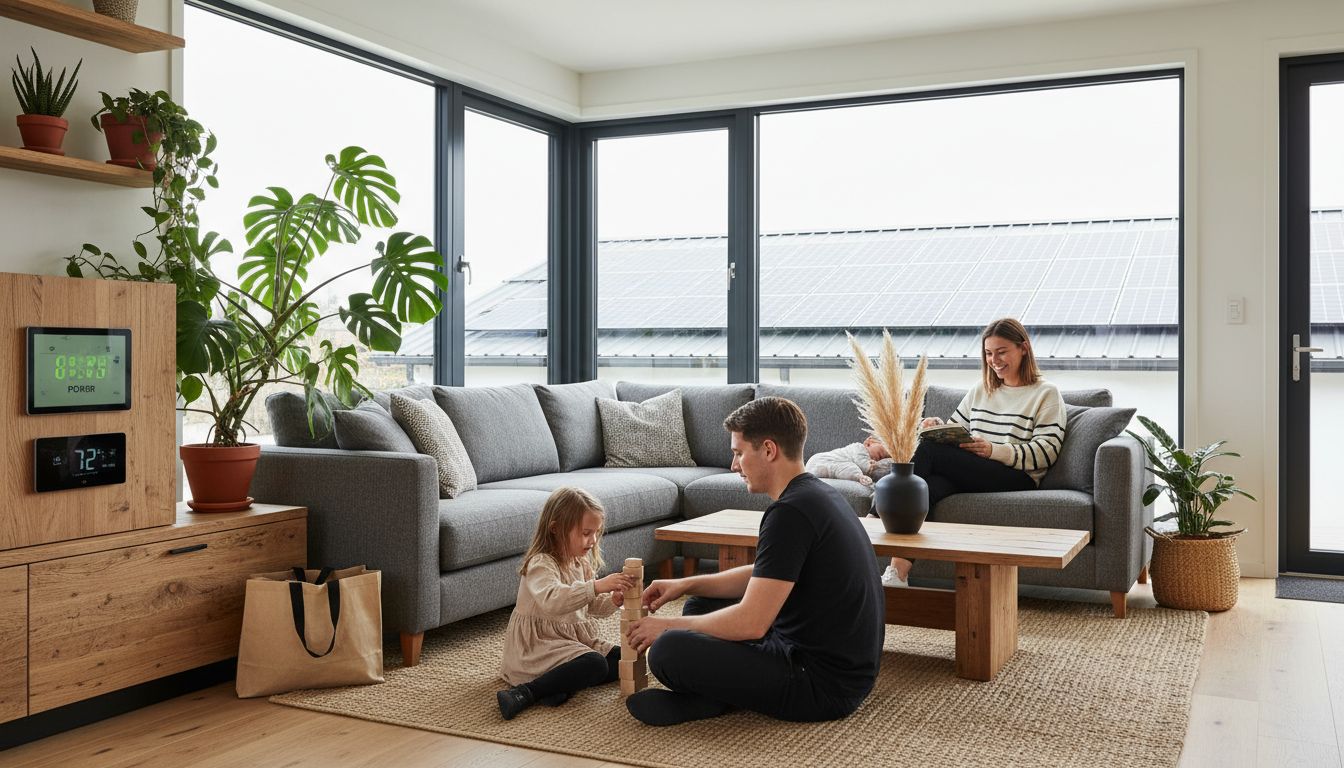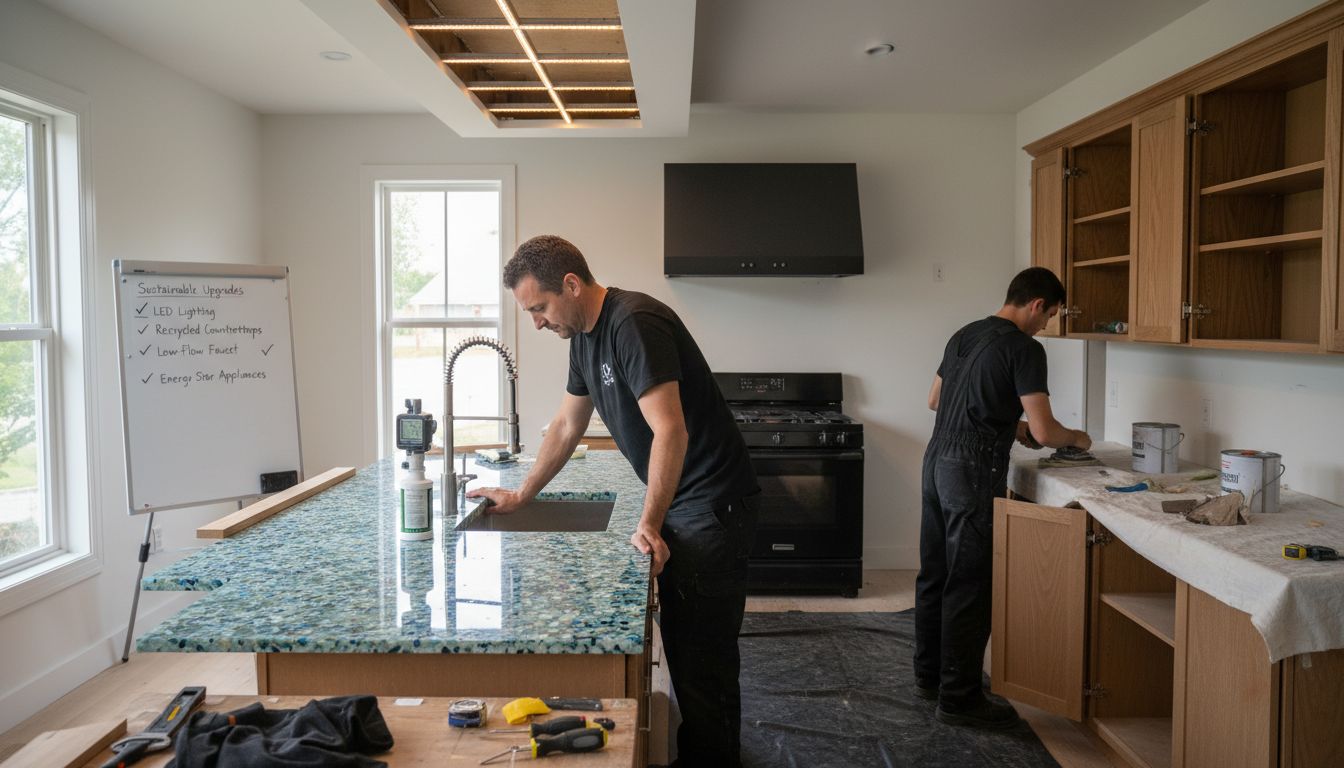Sustainable Home Practices: Complete Guide for 2025
- demoore5506
- 11 minutes ago
- 6 min read

More than 40 percent of energy use in american homes comes from heating, cooling, and powering appliances. Despite this, many families overlook simple ways to increase efficiency and lower their environmental impact. Sustainable home practices matter because they help reduce costs and shrink each household’s carbon footprint. By understanding the principles behind eco-friendly living, you can make informed choices that save money and contribute to a healthier planet.
Table of Contents
Key Takeaways
Point | Details |
Sustainable Practices | Homeowners can significantly reduce their environmental impact by implementing energy-efficient upgrades and utilizing eco-friendly materials. |
Retrofit Strategies | Understanding shallow and deep retrofits allows homeowners to choose appropriate upgrades that maximize energy savings and reduce consumption. |
Financial Benefits | Sustainable home improvements lead to long-term cost savings, increased property value, and potential government rebates. |
Avoiding Common Mistakes | Homeowners should avoid superficial upgrades and ensure comprehensive assessments to achieve meaningful energy efficiency improvements. |
Defining Sustainable Home Practices
Sustainable home practices represent a holistic approach to residential living that minimizes environmental impact while maximizing energy efficiency and resource conservation. According to Natural Resources Canada, green buildings reflect a comprehensive strategy for improving energy performance and reducing greenhouse gas emissions to ensure a healthier environment for future generations.
At its core, sustainable home practices encompass several key strategic elements that homeowners can implement to transform their living spaces. These include energy-efficient upgrades, mindful material selection, and intentional design choices that reduce overall environmental footprint. British Columbia Government Resources highlights specific interventions like:
Installing energy-efficient heating systems
Retrofitting windows for better insulation
Implementing proper home insulation techniques
Choosing eco-friendly building materials
Reducing overall energy consumption
Beyond individual home improvements, sustainable practices represent a broader commitment to responsible living. This approach goes beyond simple energy savings and touches on interconnected systems of resource management, waste reduction, and environmental stewardship. Homeowners who embrace these principles not only contribute to global sustainability efforts but also often experience significant long-term cost savings and improved quality of living.
For residents in Ottawa seeking to implement sustainable home practices, understanding local resources and specific regional guidelines becomes crucial. Learn more about sustainable kitchen design to discover how targeted improvements can make a meaningful environmental impact while enhancing your home’s aesthetic and functional value.
Types of Sustainable Home Improvements
Sustainable home improvements represent a strategic approach to reducing energy consumption and environmental impact through targeted residential upgrades. Green Communities Canada identifies two primary categories of home retrofits: shallow retrofits and deep retrofits, each offering unique benefits for homeowners seeking to enhance their property’s energy efficiency.
Shallow Retrofits provide modest yet impactful improvements, typically delivering 10–30% energy savings through low-cost interventions such as:
Air sealing techniques
Adding additional insulation
Installing weatherstripping
Upgrading to energy-efficient windows
Sealing potential air leakage points
Deep Retrofits, in contrast, represent a more comprehensive approach, aiming to reduce home energy consumption by 50% or more. These extensive upgrades involve systematic improvements to the entire building envelope and core systems.
Built Green Canada emphasizes a holistic approach that extends beyond energy efficiency to include critical aspects like sustainable materials, water conservation, waste management, and advanced building technologies.
For Ottawa homeowners considering sustainable upgrades, understanding these retrofit strategies can lead to significant long-term environmental and financial benefits.

Explore budget-friendly kitchen upgrade ideas to discover how targeted improvements can enhance both your home’s sustainability and aesthetic appeal while managing renovation costs effectively.
Eco-Friendly Kitchen Upgrades Explained
Natural Resources Canada confirms that any kitchen, regardless of its age, can be transformed into an energy-efficient space. Eco-friendly kitchen upgrades represent a strategic approach to reducing environmental impact while simultaneously improving functionality and aesthetic appeal.
Key Eco-Friendly Kitchen Upgrade Strategies include:
Replacing outdated appliances with energy-efficient models
Installing low-flow water fixtures
Upgrading to LED lighting
Using sustainable, recycled, or renewable materials
Implementing smart energy management systems
Choosing cabinet refinishing over complete replacement
British Columbia Government Resources emphasizes the importance of comprehensive upgrades that extend beyond simple aesthetic changes. These upgrades involve strategic improvements to heating systems, window efficiency, and overall insulation—each contributing to reduced energy consumption and lower environmental footprint.
For Ottawa homeowners looking to make meaningful kitchen improvements, understanding sustainable kitchen materials can provide crucial insights into creating an environmentally responsible cooking space that balances style, functionality, and ecological consciousness. The key is selecting upgrades that offer long-term sustainability and cost-effectiveness while minimizing waste and energy consumption.

Cost, Savings, and Environmental Impact
Canadian Public Health Association highlights a critical insight: improving building energy efficiency extends far beyond simple cost savings, directly contributing to enhanced indoor environmental quality, reduced air pollution, and meaningful climate change mitigation through greenhouse gas emissions reduction.
The financial dynamics of sustainable home improvements are compelling. Key Economic Considerations include:
Upfront investment costs vs. long-term energy savings
Potential government rebates and incentive programs
Increased property value from energy-efficient upgrades
Reduced monthly utility expenses
Lower maintenance costs for modernized systems
arXiv Research provides a comprehensive analysis of residential building retrofits, demonstrating that strategic investments can yield substantial returns. Their research reveals that targeted improvements not only generate significant energy cost savings but also dramatically reduce carbon footprints for residential properties.
For Ottawa homeowners seeking to balance environmental responsibility with financial prudence, exploring budget-friendly kitchen upgrade strategies can provide practical insights into making impactful yet economically sensible home improvements. The most successful approach combines immediate cost-effectiveness with long-term sustainability goals, ensuring that every investment contributes to both household efficiency and broader environmental conservation efforts.
Common Mistakes and How to Avoid Them
Green Communities Canada warns that homeowners often fall into the trap of pursuing shallow retrofits that provide only superficial improvements without addressing fundamental energy efficiency challenges. These short-term solutions might look appealing initially but fail to deliver meaningful long-term sustainability goals.
Critical Sustainable Home Improvement Pitfalls to avoid include:
Choosing aesthetic upgrades over functional efficiency
Neglecting comprehensive system assessments
Mismatching building components
Overlooking professional energy audits
Implementing disconnected, piecemeal improvements
Underestimating the importance of professional consultation
British Columbia Government Resources specifically cautions against mixing incompatible building components, such as integrating modern sealed-envelope windows with traditional building structures. This seemingly minor oversight can compromise overall system performance and negate potential energy savings.
For Ottawa homeowners seeking to navigate these complex upgrades, exploring sustainable kitchen materials can provide crucial insights into making informed, holistic improvements. The most effective approach involves comprehensive planning, professional guidance, and a strategic focus on long-term efficiency rather than quick, cosmetic fixes.
Transform Your Kitchen Into a Model of Sustainable Living
Sustainable home practices prioritize energy efficiency, cost savings, and long-term environmental impact. One major challenge highlighted in the article is how to improve your kitchen without costly, disruptive renovations while still achieving meaningful environmental benefits. Many homeowners want to reduce their carbon footprint but are concerned about expense and household chaos. You can embrace eco-friendly upgrades by choosing refinishing solutions that preserve your existing layout and materials. This approach aligns perfectly with the concept of minimizing waste and making strategic improvements that deliver both style and sustainability.
At Ottawa Cabinet Painting, we specialize in professional cabinet painting and refinishing that transforms your kitchen cabinets into a high-end look without the price or disruption of a full replacement. Our meticulous process ensures durable, beautiful finishes that support your sustainable home goals. By avoiding full tear-outs, you reduce landfill waste and keep your kitchen functional during the upgrade. Learn how we can help you make eco-friendly kitchen changes while enhancing your space by visiting our kitchen upgrade ideas. Ready to give your kitchen a fresh, sustainable update with minimal hassle Visit Ottawa Cabinet Painting today to request a quote and start your journey toward a greener, more beautiful home.
Frequently Asked Questions
What are sustainable home practices?
Sustainable home practices involve methods and upgrades that minimize environmental impact while enhancing energy efficiency and resource conservation within a home.
What are shallow and deep retrofits in sustainable home improvements?
Shallow retrofits involve low-cost, moderate upgrades, delivering 10–30% energy savings, such as air sealing and weatherstripping. Deep retrofits require comprehensive improvements that aim to reduce energy consumption by 50% or more across the entire home.
How can I make eco-friendly kitchen upgrades?
Eco-friendly kitchen upgrades can include replacing old appliances with energy-efficient models, installing low-flow water fixtures, upgrading to LED lighting, and using sustainable materials in your renovations.
What are the financial benefits of sustainable home improvements?
Financial benefits include reduced monthly utility costs, potential government rebates, increased property value from energy-efficient upgrades, and lower maintenance costs associated with modernized systems.
Recommended
Comments